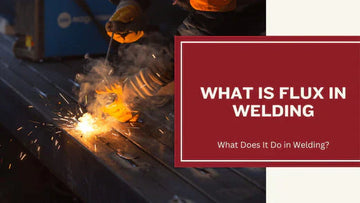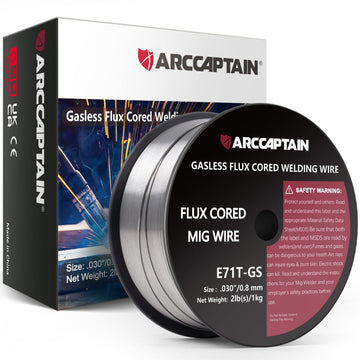
Flux in welding is a material that helps make welds stronger and cleaner. It protects the weld from things like oxygen and moisture in the air, which can make the weld weak.
Flux also helps keep the welding process steady and removes dirt or impurities from the metal. Knowing what is flux in welding is important for anyone who wants to create good-quality welds, whether you’re new to welding or already have some experience.
It’s a key part of many welding methods and helps make sure your welds are safe and long-lasting. Read on to learn more.
What Is Flux in Welding?

Flux in welding is a chemical material that helps make welds strong and clean. It plays an important role in the welding process by protecting the weld and improving its quality.
Why Is Flux Important in Welding?
-
Prevents Oxidation: Flux creates a shield to block air from reaching the weld, which stops rust and weak spots.
-
Cleans the Weld Area: It removes dirt, grease, or impurities, making the metal easier to bond.
-
Improves Weld Quality: Flux stabilizes the arc and makes the weld smoother and more durable.
Using flux helps welders create strong, safe, and reliable welds.
What is a Flux Welder
A flux welder is a type of welding machine that uses a special wire filled with flux to join metal pieces together. The flux in the wire melts as you weld, creating a gas that protects the weld from dirt and air.
This makes flux welding ideal for working outdoors or in windy areas, as you don't need a separate gas tank. It is a handy and straightforward way to create strong welds, even for beginners.
Types of Flux in Welding
Flux is a crucial part of welding, and there are different types, each designed for specific tasks. Knowing the right type to use can make your welding smoother and more effective. Here’s a breakdown of the most common types:
Comparison Table
|
Type |
Application |
Advantages |
|
Solid Flux |
Submerged Arc Welding |
Reduces spatter, strong welds |
|
Liquid Flux |
Brazing, Soldering |
Easy to apply, prevents oxidation |
|
Paste Flux |
Pipe Welding |
Stays in place, cleans welds |
|
Powder Flux |
Aluminum Welding |
Melts evenly, improves bonding |
Now, let’s discuss them one by one:
1. Solid Flux
Application: Primarily used in submerged arc welding (SAW). The flux is a granular material that blankets the arc and weld pool.
Advantages:
- Creates a slag layer that slows cooling, reducing cracking risk.
- Reusable excess flux (up to 50%) cuts material costs.
- Minimal UV emissions and spatter.
Best For: Thick steel plates (e.g., shipbuilding, structural beams) and automated, high-deposition welding.
Pro Tip: Match flux composition to wire (e.g., F7A6-EM12K flux paired with EM12K wire for high-tensile welds).
Liquid Flux
Application: Dominates soldering (electronics) and silver brazing (HVAC, jewelry).
Advantages:
- Flows into tight gaps for uniform coverage.
- Water-based formulas (e.g., ZnCl₂) dissolve oxides on copper/brass.
Best For: Circuit boards, copper piping, and intricate joints.
Warning: Leaves corrosive residues—always clean with isopropyl alcohol post-soldering.
3. Paste Flux
Application: Essential for TIG/GTAW welding of stainless steel pipes and oxy-acetylene brazing.
Advantages:
- Sticks to vertical surfaces (no drips).
- Borax-based pastes (e.g., AWS FB3-A) prevent chromium loss in stainless steel.
Best For: Food-grade piping, refrigeration systems, and HVAC repairs.
Pro Tip: Apply with a flux brush—avoid overloading to prevent porosity
4. Powder Flux
Application: Critical for gas welding aluminum (e.g., oxy-fuel torches).
Advantages:
- Disrupts aluminum’s tenacious oxide layer (melts at 3,700°F vs. aluminum’s 1,200°F).
- Sodium-free blends (e.g., No. 22 Alcoa Flux) minimize fume toxicity.
Best For: Automotive radiators, aircraft parts, and boat hulls.
Warning: Requires thorough post-weld cleaning—leftover flux causes corrosion.
How Does Flux Work in Welding?

Flux plays a vital role in welding by protecting the weld, improving its quality, and ensuring a strong bond. It undergoes a fascinating chemical reaction when exposed to high heat, which helps create durable and clean welds.
Step-By-Step Guide: What Happens When Flux is Used
1. Flux Melts:
When the heat from the welding process reaches the flux, it melts and turns into a liquid. This melted flux coats the molten weld pool, forming a protective barrier. The liquid barrier shields the hot metal from air, preventing contact with oxygen and moisture.
2. Gas Shielding:
As the flux melts, it releases gases, such as carbon dioxide or other inert gases. These gases create a shielding cloud around the weld area. The shielding gas prevents harmful reactions, such as oxidation, that could make the weld brittle or weak.
3. Cleans the Metal Surface:
The flux chemically reacts with impurities on the metal, like rust, dirt, or grease. It pulls these impurities away from the weld pool, leaving behind a cleaner surface for better bonding.
This cleaning action ensures a smoother, stronger connection between the pieces being welded.
4. Forms a Slag Layer:
After welding, the flux cools and solidifies into slag, a hard protective layer on top of the weld. The slag protects the weld as it cools, preventing exposure to air and other contaminants. Once the weld is cool, the slag can be chipped or brushed away to reveal the finished weld.
5. Enhances Weld Quality:
By shielding the weld from air, cleaning impurities, and stabilizing the arc, flux ensures the weld is strong and visually clean.
It also makes welding easier by creating a consistent arc and preventing excessive spatter.
Why Flux Matters in Welding
Flux is more than just a tool—it’s the unsung hero of welding. Without it, welds would be more prone to cracks, rust, and other defects. Its ability to shield, clean, and protect ensures that even complex welding tasks result in durable, reliable joints.
Whether you’re a beginner or an expert, understanding how flux works can help you create welds that are safe and long-lasting.
Think of flux as a helper that stands guard, keeping the weld area clean and safe while ensuring your hard work results in a job well done!
What Is Flux in Welding Processes?
Welding is a process of joining two or more metal pieces together by melting them and allowing them to cool and fuse. Flux is a material used in welding to protect the weld area from atmospheric gases such as nitrogen and oxygen. It also helps to remove impurities from the weld area and creates a slag that can be easily removed.
Flux in Arc Welding
Arc welding is a welding process that uses an electric arc to melt the metal pieces together.
In this process, flux is used to protect the weld area from atmospheric gases and to create a slag that can be easily removed. Shielding gas is also used to protect the weld area from atmospheric gases.
Flux-Cored Arc Welding (FCAW)
Flux-cored arc welding (FCAW) is a welding process that uses a tubular electrode filled with flux. The flux in the electrode protects the weld area from atmospheric gases and creates a slag that can be easily removed. FCAW is commonly used in construction and shipbuilding industries.
Submerged Arc Welding (SAW)
Submerged arc welding (SAW) is a welding process that uses a granular flux to protect the weld area from atmospheric gases. The flux is fed into the weld area through a hopper and creates a slag that can be easily removed. SAW is commonly used in the manufacturing of pipes, tanks, and pressure vessels.
Shielded Metal Arc Welding (SMAW)
Flux is an essential material used in many welding methods to protect and improve the weld. In Shielded Metal Arc Welding (SMAW), the electrodes are coated with flux.
When heated, the flux melts and creates a gas shield around the weld to block oxygen and moisture. It also forms slag, a protective layer that covers the weld as it cools, preventing contamination.
The flux-coated electrodes in SMAW make it easier to produce strong, clean welds. This process is widely used for its reliability and ability to work well in outdoor or rough conditions.
Choosing the Right Flux for a Great Weld with ArcCaptain
Getting the perfect weld is all about picking the right flux.
Here's the deal: think about how you're welding, what metal you're working with, and what you want your weld to be like. The key is to check out what the folks who make the stuff say – they know their product best.
And when it comes to flux, "flux core wires" from ArcCaptain are a top choice. They're made just right for all kinds of jobs, helping you get strong, clean welds every time. Remember, using the flux that fits your project makes all the difference!
Flux Handling and Storage
Proper handling and storage of flux is essential to maintaining its effectiveness. Flux should be kept in a dry and cool environment to prevent moisture absorption and degradation. It is important to follow the manufacturer's guidelines for handling and storage to ensure the flux remains usable.
Safety Precautions
Welding with flux can produce toxic fumes, gases, sparks, splatter, and debris. It is crucial to follow safety precautions to protect yourself and those around you.
Proper ventilation and personal protective equipment, such as respirators, gloves, and safety glasses, should be used. It is important to regularly maintain and repair welding equipment to prevent accidents and ensure its safe operation.
By choosing the right flux, handling and storing it properly, and taking safety precautions, welders can achieve high-quality welds while protecting themselves and those around them.
Conclusion
Flux is essential in welding, protecting molten metal from contaminants like oxygen and moisture while stabilizing the arc for cleaner, stronger welds.
Its performance depends on both technique and equipment—pair it with purpose-built tools to maximize results. Synergic MIG welders automate settings for seamless flux-core application, TIG welders provide precise control for flux-free joints, and stick welders excel with flux-coated electrodes in demanding environments.
For projects requiring durability and precision, the right gear ensures flux works efficiently. Explore ArcCaptain’s curated welding equipment to match your flux welding needs, and elevate your craft with equipment engineered to meet your needs.
FAQs on What is Flux in Welding
What is the function of flux?
The function of flux in welding and soldering is to clean and prepare the metal surfaces to ensure a strong, clean joint. Flux removes oxidation and impurities from the metal, which can interfere with the bonding process. It also helps to prevent new oxidation during the heating process, ensuring a better-quality weld or solder joint.
Why do you need flux for welding?
You need flux for welding because it helps to clean the metal surfaces and remove any oxides or impurities that could weaken the weld. Flux also provides a protective barrier against oxidation during the welding process, ensuring a stronger and more reliable bond. Using flux results in a cleaner, more efficient welding process and better overall weld quality.
What is flux and what is its purpose?
Flux is a chemical cleaning agent used in welding and soldering to remove oxidation and impurities from metal surfaces. Its purpose is to ensure a clean, strong bond between the metals being joined. By preventing oxidation during the heating process, flux improves the quality and durability of the weld or solder joint.
What is the main use of flux?
The main use of flux is to clean metal surfaces and prevent oxidation during welding and soldering. This ensures a strong and reliable bond between the metals. Flux is essential for achieving high-quality joints, as it removes contaminants that could weaken the connection.
Can I solder without flux?
While it is possible to solder without flux, it is not recommended. Soldering without flux can result in weak, unreliable joints due to the presence of oxidation and impurities on the metal surfaces. Using flux ensures a cleaner, stronger bond and improves the overall quality of the solder joint.

